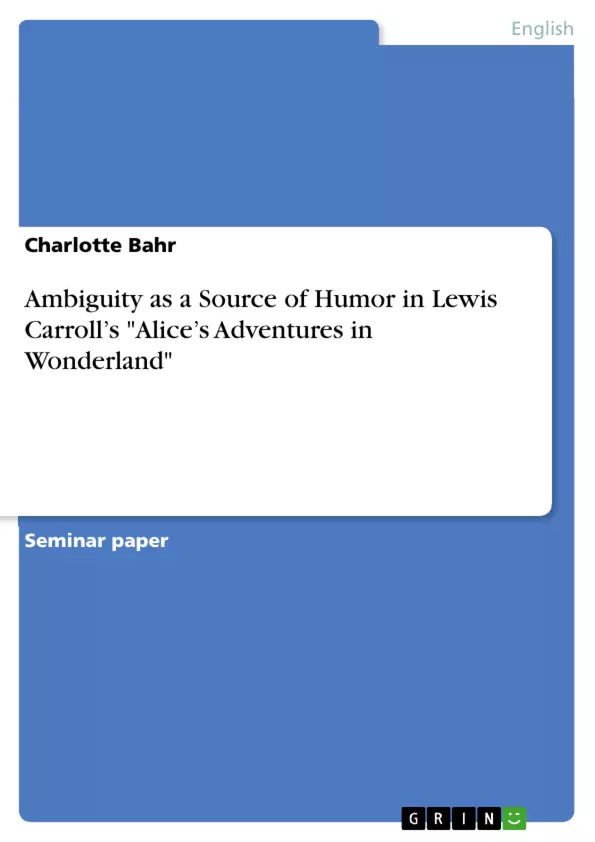"But I don’t want to go among mad people,’ Alice remarked.
‘Oh, you can’t help that,’ said the Cat: ‘we’re all mad here. I‘m mad. You‘re mad." This quote captures like nothing else the essence of Lewis Carroll’s classic children’s book Alice in Wonderland. The story of a young girl getting bored during a hot summer day and slipping into a dreamland full of odd creatures has enchanted generations of children myself included. Alice is not a typical children’s book though, as it is quite multilayered, thanks to Carroll’s clever play with language. Carroll, common name Charles Lutwige Dodgson, was quite fond of using several stylistic devices like punning, to delight the young readership his stories were for. But I also noticed that he used ambiguity in quite a few instances. Many characters are very fond of ambiguity most prominently The Cheshire Cat, the Mad Hatter, the Mock Turtle, Gryphon and the Red King. Carroll mostly uses ambiguity to create confusion through misunderstandings, mostly on Alice’s dispense, which in return tends to create a certain humor for the reader.
In this seminar paper I will discuss Carroll’s use of ambiguity in Alice’s Adventures in Wonderland by analyzing several instances of it that appear throughout the novel. I will start out by defining ambiguity and in what ways ambiguity has been researched by other linguists and what results their studies produced. I am also going to explore the origins of Alice in Wonderland. How did Carroll come up with it? What kind of story is it? On the stylistic level I will examine what Carroll’s general stance on ambiguity was and how he used it to create both confusion and comedy? I will take a closer look at the different forms of ambiguity he employs and how characters react to the usage of it.
Inhaltsverzeichnis (Table of Contents)
- Introduction
- Literary background to Alice's Adventures in Wonderland and Ambiguity
- Background Studies on Ambiguity
- Background Studies of Ambiguity in Alice's Adventures in Wonderland
- Analysis of the Ambiguity in Alice's Adventures in Wonderland
- The Caucus Race and a long Tale
- The Queen's Croquet-Ground
- The Mock Turtles Story
- Conclusion
- Bibliography
Zielsetzung und Themenschwerpunkte (Objectives and Key Themes)
This seminar paper aims to analyze the use of ambiguity in Lewis Carroll's Alice's Adventures in Wonderland. It will examine how Carroll uses ambiguity to create confusion and humor, exploring the different types of ambiguity present in the text and how characters react to them. The paper will also investigate the literary background of the novel and its significance as a children's book as well as a work with deeper meaning for adults.
- Ambiguity as a stylistic device in Alice's Adventures in Wonderland
- The impact of ambiguity on the narrative and character interactions
- The literary context of the novel and its appeal to both children and adults
- The use of humor and nonsense in Carroll's writing
- The exploration of language, meaning, and identity in the novel
Zusammenfassung der Kapitel (Chapter Summaries)
The introduction establishes the topic of the paper, outlining the use of ambiguity in Alice's Adventures in Wonderland. The literary background of the novel is explored, highlighting its origins and its appeal to both children and adults. The chapter then delves into the definition of ambiguity and its various forms, drawing on linguistic research to contextualize Carroll's use of this literary device. It concludes by outlining the scope and purpose of the paper.
The second chapter continues the exploration of ambiguity, specifically focusing on its role in Alice's Adventures in Wonderland. The chapter examines how ambiguity contributes to the novel's humor and its disorienting nature, particularly as experienced by Alice. It will also highlight the role of certain characters, such as the Cheshire Cat, in creating and manipulating ambiguity for comedic effect.
The third chapter dives deeper into the analysis of specific instances of ambiguity within the novel. The chapter examines scenes such as the Caucus Race, the Queen's Croquet-Ground, and the Mock Turtle's Story, demonstrating how ambiguity plays a pivotal role in shaping the narrative and character interactions in these scenes. It explores the effects of ambiguity on Alice's understanding of Wonderland and the humorous consequences of her misunderstandings.
Schlüsselwörter (Keywords)
This seminar paper examines the use of ambiguity in Lewis Carroll's Alice's Adventures in Wonderland. Key terms include ambiguity, humor, nonsense, children's literature, literary background, linguistic analysis, stylistic devices, and character interaction. The paper focuses on the interplay between ambiguity and meaning, examining how this literary device shapes the narrative and contributes to the novel's lasting appeal.
- Quote paper
- Charlotte Bahr (Author), 2012, Ambiguity as a Source of Humor in Lewis Carroll’s "Alice’s Adventures in Wonderland", Munich, GRIN Verlag, https://www.grin.com/document/232605



